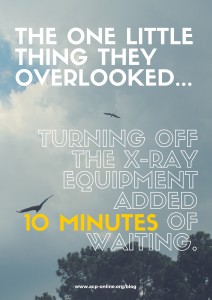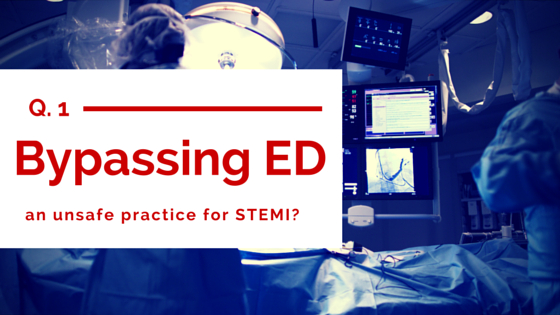 In 2015, Sentara Rockingham Memorial Hospital in Harrisonburg, Virginia earned the American College of Cardiology's ACTION Registry®-GWTG™ Platinum Award for the second consecutive year for providing superior care to high-risk STEMI patients.
In 2015, Sentara Rockingham Memorial Hospital in Harrisonburg, Virginia earned the American College of Cardiology's ACTION Registry®-GWTG™ Platinum Award for the second consecutive year for providing superior care to high-risk STEMI patients.
Sentara RMH was also recently awarded the American Heart Association Mission: Lifeline® Silver Award for STEMI.
An important quality consideration in the ACTION Registry, door-to-balloon time sets Sentara RMH and its cardiac team apart.
In a recent interview, cardiac operations manager Linwood Williams reported that Sentara RMH's average door-to-balloon time is 46 minutes compared to the national average of 59.2.
We reached out to Williams, an active Alliance of Cardiovascular Professionals member, to profile his excellent cardiac team and ask the question---how did they improve STEMI?
Streamlining STEMI
 Williams has a great deal of experience streamlining the STEMI process and lowering door-to-balloon times. "I worked at Lynchburg---we were some of the first pioneers to start breaking down the door-to-balloon process," said Williams.
Williams has a great deal of experience streamlining the STEMI process and lowering door-to-balloon times. "I worked at Lynchburg---we were some of the first pioneers to start breaking down the door-to-balloon process," said Williams.
Sentara RMH does a lot of the tried-and-true process optimization techniques, like completely setting up rooms for STEMI at the end of the day, requiring a 30 minute response time for staff and activating the cath team by the emergency department.
But in every practice, there are some things you might simply overlook, so they had a process improvement specialist consult them, reported Williams.
The specialist noticed the team was turning x-ray equipment off at night despite having the rooms set up for STEMI---that resulted in 10 minutes of waiting for the x-ray equipment to boot up during an emergency STEMI.
"He asked, 'Why do you turn it off?'" said Williams, to which he did not have a good answer. Sentara RMH now leaves the x-ray machines on at night for STEMIs.
Williams finds benefits in repeating the improvement process regularly. "We've repeated the process over the years, and each time there's a minute saved here, a minute saved there," he said.
The caution flag
Williams cautions that not every practice for reducing door-to-balloon time promotes patient safety. "There are some unsafe practices in my view," said Williams, like sending a patient to the STEMI room before the team gets there.

But what really contributed the most to improve STEMI for Sentara RMH?
Calling STEMI from the field
"We activate a lot of STEMIs from the field---that's a 30 minute head start," said Williams.
It was a difficult decision to begin activating STEMIs from the field, said Williams---one that was initially a massive strain on the on-call team. "We have a false call rate of 18 percent, but at one time that was up to 50 percent," said Williams.
With such a high rate of false calls, the early activation question was still in play. "Do we stop activating early? We had to prove the value of it," said Williams.

To this question, the entire cardiac team at Sentara RMH responded. "They stood up and said, no---we would rather come in with a false than miss one we should have gotten," said Williams. "They were as passionate about getting it as I was."
But with only three cardiologists that could be on-call for STEMI procedures, the strain was too much, and Sentara RMH faced a simple choice---either reduce the false call rate or stop activating from the field.
"That's what got us out to the field to work with the EMS---to cut down on false calls," said Williams.
Educating EMS
Team members, again, stepped up to improve STEMI calls by providing education to EMS. Team members regularly meet with EMS squads and educate them about recognizing heart attacks, using EKG equipment, and other important considerations like gender differences in cardiac arrest.
Sentara RMH also donated 16 portable 12-lead EKG monitors to local EMS squads that didn't already have them.
The results have been clear---the false call rate is now only 18 percent---and the initiative pays dividends for the team.
"They like doing it---going out and meeting with the squads," said Williams. "It's a great back and forth between groups."
News Update: A new report from the Institute of Medicine endorsed by the American Heart Association recommends enhancing the capabilities and performance of EMS systems to improve survival from sudden cardiac arrest.
Stay tuned for part two of our profile of Sentara RMH's excellent cardiac care team---we've got plenty more management insights into this stellar team!
Remember you can subscribe to be updated via email on new posts using the option on the sidebar.
Before you go---answer Linwood's questions! What does your team do to optimize emergency STEMI? Do you activate from the field? Are there any door-to-balloon time reducing practices you think are unsafe? Leave a comment below!
We also activate from the field! Patients who arrive by EMS during regular business hours are brought directly to the lab, if available, which reduces door-to balloon time significantly. I also requires extra RN staff to facilitate medication administration, lab draws, and basic patient information.
How does your facility handle informed consent for the procedure? Are STEMI procedures considered “an emergency” procedure and documented as such?
Your process seems very similar to our own. Out of our 3 person call team, I require that 2 of the members be RNs for the same reasons that you listed your second RN.
Informed consent is obtained when possible, the MD describing the procedure to the patient as we go from ED to cath lab. In cases where the patient cannot give consent however, we do document these as an emergency procedure. We will send the nursing coordinator out to get consent from the family when they arrive, but the procedure is well under way by then.